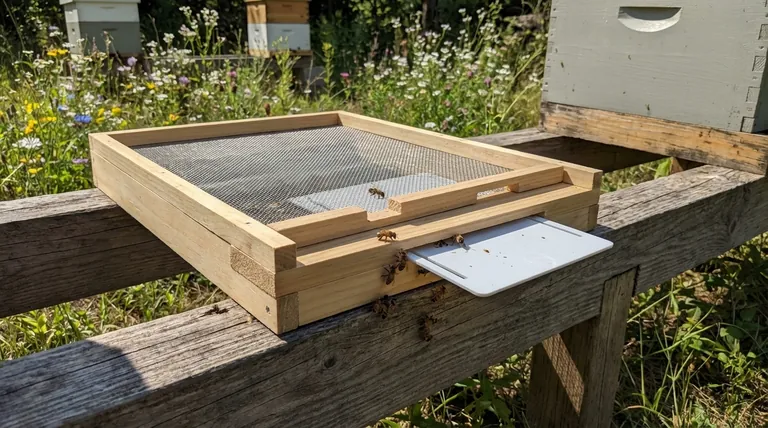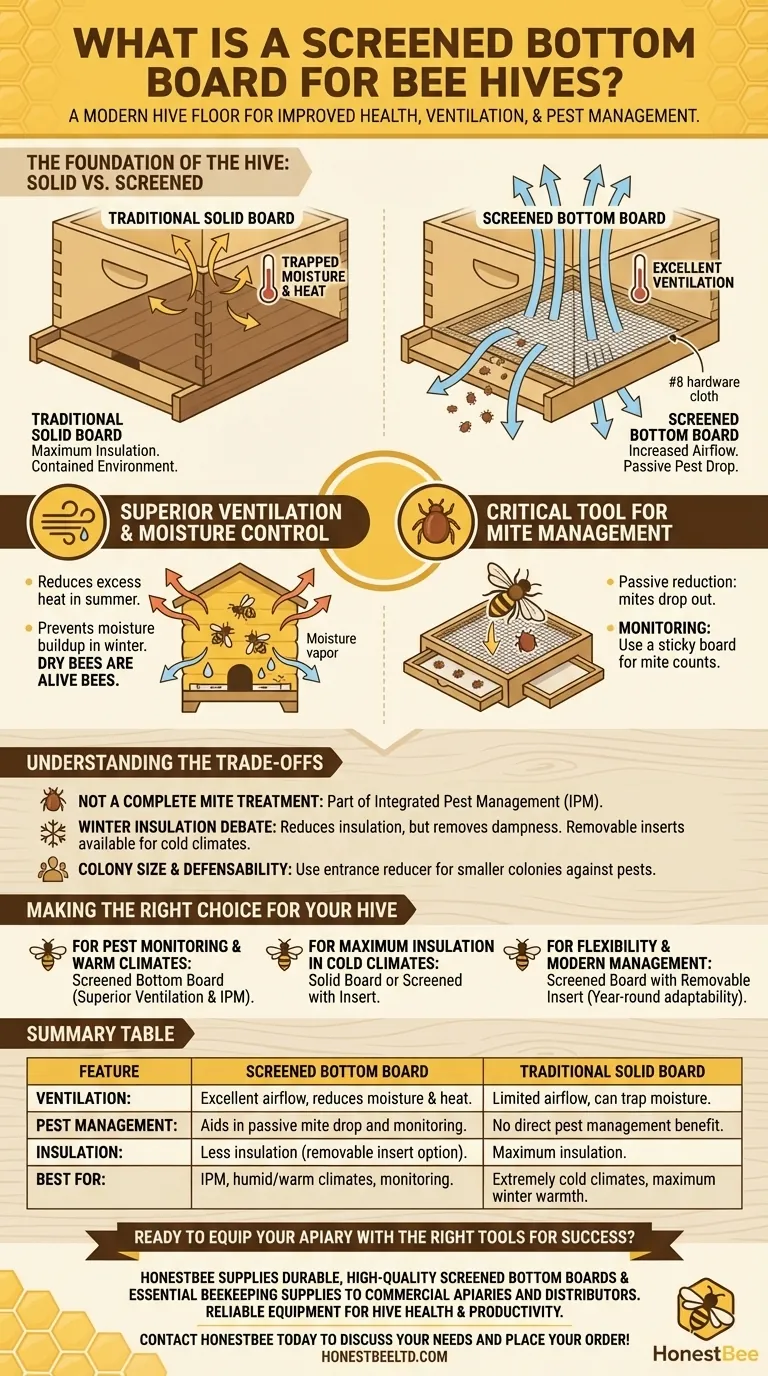At its core, a screened bottom board is a modern hive floor designed with a wire mesh panel instead of a solid wood base. This simple change from a traditional solid board fundamentally alters the hive's internal environment, primarily to improve hive health by increasing ventilation and aiding in pest management.
A screened bottom board is not just an alternative floor; it's a management tool. Its primary value lies in providing the beekeeper with greater control over two of the biggest threats to a colony: moisture and Varroa mites.

The Foundation of the Hive: Solid vs. Screened
A bottom board serves as the floor and entrance to the entire hive structure. It's the launch and landing pad for all foraging bees and the first line of defense against intruders. The choice between a solid and a screened board dictates the level of environmental control you have.
The Traditional Solid Bottom Board
The classic solid bottom board is a simple wooden plank. It provides maximum insulation from the ground and creates a contained environment that is easier for the colony to defend and maintain a stable temperature.
The Screened Bottom Board Advantage
A screened bottom board replaces the central wood panel with a durable, #8 hardware cloth (a mesh with 8 squares per inch). This design allows air to circulate freely and small debris, including pests, to fall out of the hive.
Key Benefits of a Screened Design
The decision to use a screened bottom board is driven by the desire to proactively manage the hive's internal climate and pest load.
Superior Ventilation and Moisture Control
Proper ventilation is critical. In hot summer months, a screened bottom allows excess heat to escape, reducing the energy bees must expend fanning to cool the brood nest.
In winter, ventilation is even more crucial. A colony's respiration produces significant water vapor. In a sealed hive, this moist air condenses on cold surfaces, dripping back onto the bees. Wet bees are dead bees, and a screened board allows this moisture to escape, keeping the cluster dry.
A Critical Tool for Mite Management
The Varroa destructor mite is a devastating honey bee parasite. A screened bottom board helps in two ways.
First, when mites lose their grip and fall from a bee, they can drop through the screen and out of the hive. This passive reduction can lower the mite population by up to 20%.
Second, and more importantly, it allows for monitoring. By sliding a white, sticky board (called a "Varroa board" or "slider") underneath the screen, you can perform a "mite drop count" to accurately assess the infestation level and decide when treatment is necessary.
Understanding the Trade-offs
While beneficial, a screened bottom board is not a universal solution. Understanding its limitations is key to using it effectively.
It Is Not a Complete Mite Treatment
Relying solely on a screened board for mite control is a critical mistake. It is one component of a larger Integrated Pest Management (IPM) strategy. Passive mite drops are helpful but are never enough to control a significant infestation.
The Winter Insulation Debate
The most common concern is that a screened board makes the hive too cold in winter. While it does reduce insulation, the benefit of removing damp, stagnant air often outweighs the downside of increased airflow. A dry, cold bee is far more likely to survive than a wet, cold bee.
For beekeepers in extremely cold climates, many screened bottom boards come with a removable insert that can be slid in to close the screen during the harshest parts of winter, offering the best of both worlds.
Colony Size and Defensibility
A large, open floor can be a challenge for a small or young colony to defend against pests like mice or wax moths. Using an entrance reducer is highly recommended to shrink the entrance size, making it easier for the guard bees to protect their home.
Making the Right Choice for Your Hive
Your decision should be based on your climate, management style, and specific goals for your apiary.
- If your primary focus is pest monitoring and warm-climate beekeeping: A screened bottom board is the superior choice for ventilation and IPM.
- If your primary focus is maximum insulation in an extremely cold climate: A solid board, or a screened board with its insert closed for the winter, is a more suitable option.
- If your primary focus is flexibility and modern management: A screened bottom board with a removable insert provides year-round adaptability for any climate or situation.
Ultimately, choosing the right bottom board is about selecting the best tool to help your bees thrive.
Summary Table:
| Feature | Screened Bottom Board | Traditional Solid Board |
|---|---|---|
| Ventilation | Excellent airflow reduces moisture & heat. | Limited airflow, can trap moisture. |
| Pest Management | Aids in passive mite drop and monitoring. | No direct pest management benefit. |
| Insulation | Less insulation (can use a removable insert). | Maximum insulation from the ground. |
| Best For | IPM strategies, humid/warm climates, monitoring. | Extremely cold climates, maximum winter warmth. |
Ready to equip your apiary with the right tools for success? HONESTBEE supplies durable, high-quality screened bottom boards and other essential beekeeping supplies to commercial apiaries and distributors. Our wholesale-focused operations ensure you get the reliable equipment you need to promote hive health and productivity. Contact HONESTBEE today to discuss your needs and place your order!
Visual Guide

Related Products
- Langstroth Screen Bottom Board for Beekeeping Wholesale
- Australian Pine Wood Langstroth Screen Bottom Board for Wholesale
- Solid Bottom Board Australian Pine Wood Langstroth Bottom Board for Wholesale
- HONESTBEE Wooden Bee Escape Board with Triangle Mesh Design for Beekeeping
- Professional Insulated Winter Hive Wrap for Beekeeping
People Also Ask
- What are some considerations when choosing between solid and screened bottom boards? Optimize Hive Health & Pest Control
- How should the screened bottom board be used throughout the year? A Guide for Healthy Hives
- What are the benefits of using a screened bottom board in warm or humid climates? Boost Hive Health & Control Pests
- How does a screened bottom board assist with temperature control and pest management? A Key Tool for Modern Beekeeping
- What are the benefits of using a screened bottom board for beehives? Improve Ventilation & Mite Control



















